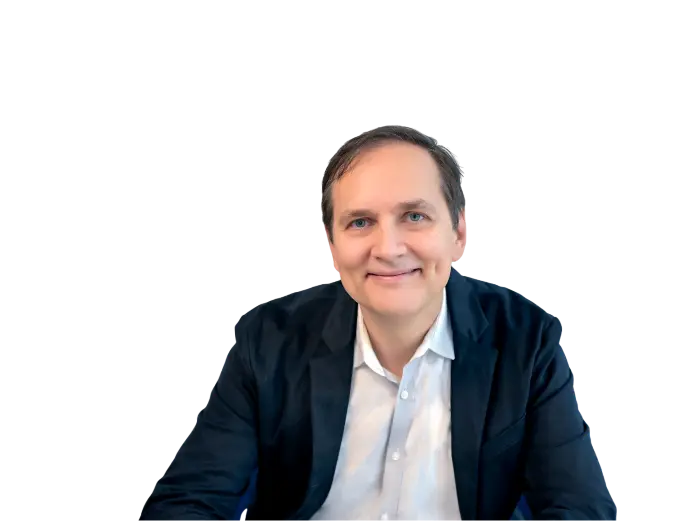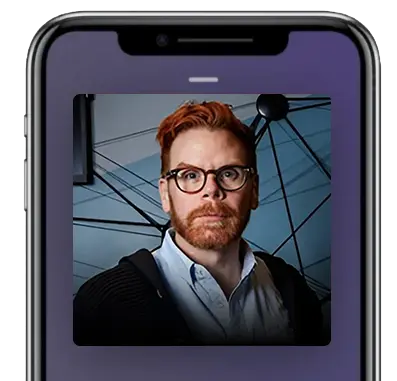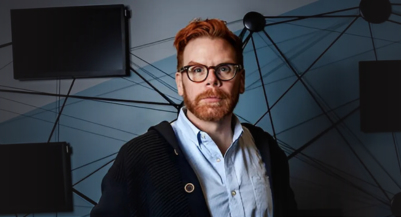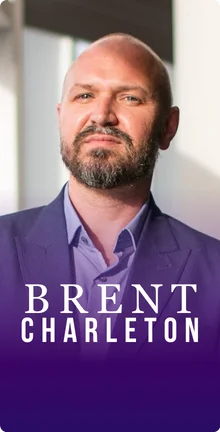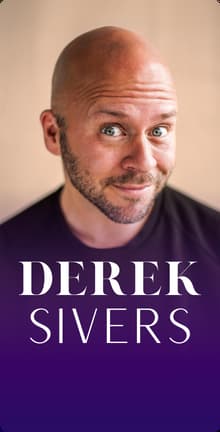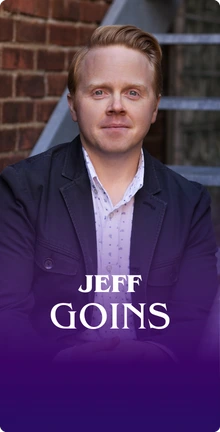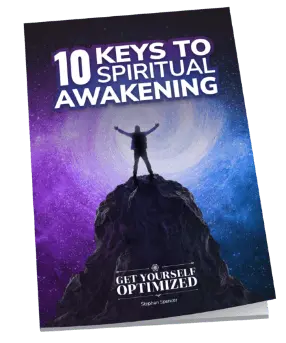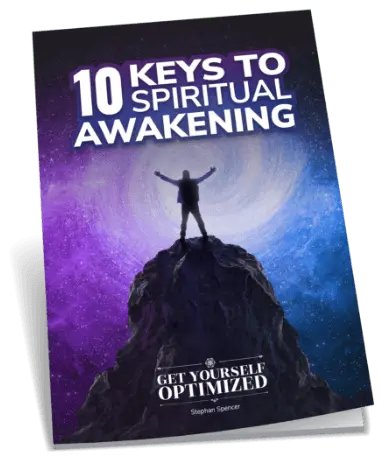In this Episode
- [03:40]Chris Dancy discusses the concept of mood journaling, using a tool called Mood Panda, and explains the difference between moods and emotions.
- [14:16]Chris reflects on his media coverage, which started when a journalist at a conference noticed his Google Calendar and IFTTT integration.
- [27:36]Chris explains his method of keeping a journal to record synchronicities and looking for patterns and times.
- [34:24]Chris introduces the concept of phone palmistry and how people’s relationships with their phone battery percentages reflect their attitudes towards control.
- [42:32]Chris shares his experience with posture tracking using LUMO and how he now uses his phone’s gait sensor for similar purposes.
- [46:45]Stephan and Chris talk about the potential for AI to create immersive historical experiences and the impact on cognitive time travel.
- [50:11]Chris emphasizes the importance of being authentic and vulnerable in sharing his experiences and helping others.
Chris, it’s so great to have you on the show. First of all, I’d love to know why you ended up writing your book, Don’t Unplug.
Thanks so much. I’m excited to be here.
Yes, all of us authors get just boatloads of cash coming in from that.
Get paid a lot of money.
That’s right!
Well, no, seriously, I went out to auction and I got a lot of money. It was like a quarter of a million dollars. When I was approached about writing the book in 2015, I had no ambitions to write a book or anything like that. It was a lot of work. But then the more I got involved and understood the uniqueness of maybe my perspective, the more I thought, “Oh, this might be nice.”
My favorite part was writing the book, but I also got to read it on Audible. Usually, they hire a voice actor, but they wanted me to be my own voice. Imagine that. It turned out to be one of my favorite things because, with the onslaught of AI in the world, I’ve been able to use the eight hours of reading my story to train many models.
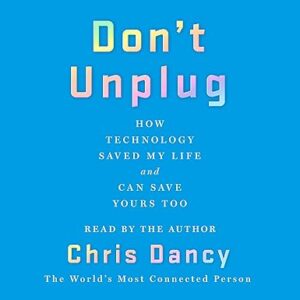
That’s cool. I read some of it. What I read was really good, and it provided some very practical advice about things like what to have set up on your smartphone and what not to, as well as the kinds of things to include in your journal. I never thought of keeping a mood journal to track my mood. I just thought, “Wow, this is really innovative stuff. You don’t hear these kinds of tidbits of advice every day in this type of setting.” A typical productivity podcast and so forth. I love it. If you want to share some of the best tips and tricks that you’ve come up with, which are not just the same old recycled information you hear over and over again.
Oh my goodness, first of all, let’s remember that this book was written over 10 years ago. A lot of the things I was doing then, I still do now, but they look different. I mean, you mentioned mood, it’s totally funny. I totally forgot I had a whole part in the book about mood journaling. I actually used something called Mood Panda back then. Often, what I’ve learned about mood and emotions causes many people to misunderstand how thoughts and feelings interact to create moods and emotions.
Moods are just emotions strung together for a period of time, in which you can have a point of view. That’s a mood. Whereas an emotion is something singular that will, within you, that might be autonomous, you’re not with anyone or with other people, and only becomes a move when there’s a little bit more bidirectionality in it, because other people sense your mood. But that being said, when I was starting to hyper-document my life starting in 2008, you’re using a lot of technology. It soon became apparent to me that much of what I thought was merely mindless, habitual behavior was actually linked to my mood and emotions. Like overeating, particularly, some people even say they emotionally eat, but for me, it was more than that. It was emotional spending. It was emotional sex. Everything was emotional.
Getting my head around that to understand what the precursors of some of my behaviors are. I’m sorry, some of my feelings, because they just didn’t happen. I ended up creating what I would call Gartner, which has something called a hype cycle, which is a crazy fancy term for understanding how software gets adopted within the world. But I created something almost like a mood map so I could understand how things went through my life because it was super important.
Moods are just emotions strung together over time, giving you a point of view others can sense.
For me, to get my head around it, I had to realize that I didn’t end up in these black holes where I was time-blind and obsessed with something, and then totally never thought about it again. I felt a lot like I had almost a real relationship with a person, but everything in my life came and went that way. Within that cycle, I had a bunch of moods. The Mood Panda was great because it was simple. ‘How are you feeling?’ Today, it’s literally Apple does it on their watch, you can check in, and it’s a little gradient slider. It’s so commonplace. There’s even a journaling app within the Apple and Android ecosystems. It’s a lot.
How do you track this these days?
Well, nowadays, it’s a lot simpler. I have a pendant that I wear called Limitless. It’s an AI company, and they have two modes. They have both hardware and software modes. In software mode, the software just lives on your computer. It’s recording a meeting. The pendant mode just records what you say all day. Obviously, there’s a lot of feedback you get from listening to yourself. I have that as one level. I have another level where I subjectively measure how I’m checking with myself.
I have a third one that just goes through my interactions that are audio in nature. Text, email, etc., throughout the day, and give them a scoring of sorts. At the end of the day, those three types of emotional feedback are actually emptied into a system. That system then provides me with a general overview of my day. I can give you a demo and show you what it looks like.
That’d be great.
What to avoid is just as important as what to embrace.
This is some journaling that came in throughout the day, just me talking and thinking. The AI will proceed to create a mood map based on what I’m saying. At the bottom of the screen, it captures the places I go, tasks I complete, people I email or text, and bills I pay—just a lot of stuff. I have a lot of low-friction data collection. But at the end of the day, it gives me an overview based not only on that day’s behavior, but also because it’s got almost 20 years’ worth of my life in it, it kind of looks at it overall, like how you should be really focusing on and what I should really be avoiding. Like who and what to avoid are just as important as who and what to embrace, if that makes sense.
How do you use it? Give me an insight or some sort of behavior change or whatever that came about because you’ve been measuring this and documenting this recently.
Wow, I’m about to hit 60. As I’ve gotten older, I don’t have as much behavior change as I did in my early 40s when I started using these feedback loops. Back then, everything from quitting drinking to quitting smoking to a lot of just really bad, toxic, habitual behavior with people, places and things, a lot of that went from keeping track of how I was doing. Back then, I had a system that put it all, believe it or not, in a Google calendar. I had hundreds of Google calendars, and they would just write to them. Today, more of the behavior is what I call noticeable changes, rather than internal. I just noticed myself.
I’m thinking of a way to phrase it effectively. I’m more patient with my own mind. My mind hasn’t changed at all. I’m just as focused and frenetic as I ever would. But I’m a little bit more when I observe something within myself, a behavior that I’m not comfortable with or within other people, I actually will take a beat. Whereas five years ago, I would have been quite upset by it. But I just think it’s one of those things that getting older is nice.

Does it help you to be more disciplined? Or is there a different app or a different tool that you incorporated into your life that helps you with discipline?
Interesting. Discipline is actually in the system that I created. Years ago, I was basically using Maslow’s Hierarchy of Needs. There’s a great image of it. There are a number of images, but I basically mapped all the apps in my life to that. For me, lack of discipline came from not really focusing on what I would call the right priorities at the right time. I have to put it not so. It’s hard because some people are like, “I can’t eat better.”
Well, if you live in a food desert, it’s going to be hard to really eat well. It’s not a discipline problem if you’re in some place where you can’t get healthy, fresh food. It’s not a discipline problem if you can’t afford a fresh, healthy meal because prices are high. But I’d say for me, after I got out of that Mezzo’s hierarchy of needs mapping, I shifted to what I call value-based mapping. Basically, within my life, I sat down for the first time. I would have done this much sooner. Being 46 was late, but I wrote down my values.
‘What are the things that are important to me? What are the things that are important to my family?’ Then, I created almost some dashboards, or maybe ‘dashboards’ is a bad word for it, but I created some guardrails around these things. If you look at a health value, like ‘what does that really mean for me? What is health? You mean like how healthy I am or in my body?’ Having that system of guardrails and that system of nomenclature to tie things back to became extremely useful.
Tracking my time through a value-based system has become a guiding framework for how I live my life.
If I look at a common day, and I look at just the statistics on a common day, almost everything in my life falls into one of those. We talked about health. I’ve got mental, spiritual, emotional, physical, financial, and all the data that ties back to that, but I also have a home. A lot of people are at home, like “where are you?” I’m like, “No, it’s actually, it’s how you behave in spaces where you feel safe, right? Whereas family, people you relate to, not really the people you keep close, right?” That could be friends, and so on. That value-based system of tracking how I spend my time became a more guiding framework for how I live my life. Most people think they have a set of values.
But what they really have is a current hobby that they value by default or more generational. Most people’s values don’t change in a lifetime; usually, they can change just because of aging. Your values at 71 are going to be a lot different from what they were at 31, but that’s dictated through time itself. You don’t have as many things that you’re trying to juggle at 71 as you did at 31. Or the focus is different.
It’s been provocative to have a system like this to explain my behavior to other people. Because sometimes it’s like, “Why did you even do that? Why did you say that?” For me, work is one of my core values. Within that work value system, it’s important to do this type of work. That doesn’t explain how that affected me. Well, you and I don’t know each other that well. This means that until I’m closer to you, your family, and some of the work, it will always take precedence.
The only thing that supersedes all of those things is service. That is what I do for the world, unknown by the world to be a decent human. Those things, they’re just, I record them, but they’re never shared publicly because it wouldn’t really be an act of service if we were talking about how much you did.
Can you give us a hint at something that you don’t want to share publicly, but is a service that you’ve done for humanity, to align with that high value?
The only thing that supersedes all other values is service—quiet acts that make me a decent human, even if the world never notices.
In November, I’ll look for strangers online and help them go home for the holidays. I often build systems for communities, particularly AI-based systems, over the last five to 10 years, to help them run things and simply ask, “Have you ever considered this?” I found this on the internet and pretended I didn’t know what it was, then gave it to people. I’m really random about my service value because it has to.
Of course, look and feel anonymous, but secondly, have some impact that will be life-changing for others or else, you could do simple acts of service. In the last 10 years, I’ve noticed people don’t believe in taking trash out of the movie theater. I don’t know why. I don’t know when that started. Just like people don’t believe in returning carts at the grocery store. I don’t know why. I don’t know when that started. But simple acts like that are just a real quick and easy way. Some people are wired that way.
Yeah, picking up trash when you’re walking your dog or something like that is something that you’re changing your world and being the change you want to see in the world, kind of butcher the quote from Gandhi. ‘Who knows how many people will notice that? You’re not out there to do it, so you won’t get kudos for it or anything. But you are being a model. For others, whether you’re ignoring the trash and walking over it, or you’re bending over and picking it up and throwing it in a nearby trash can.’
There’s a lot of what I would call stunt service work in the world today. MrBeast is famous for stunts, which I would call stunt service work. “We cured 5,000 people’s blindness, you blah, blah.” He has a big video about it, and a lot of people are really defensive around Mr. Beast and those who do these kinds of stunts. But for me and my belief system and my value system, God’s worth.
Yeah, and the more that you try to get credit from others, the less you’ll get from above.
Yeah. It’s really famous. It’s interesting because, if you look at my story, you’ll see how I got a book deal from TV shows and all the other things that happened. I never set out to become known as the world’s most connected person. It happened because I suddenly cared about myself in a way that was so selfless, but then I was noticed by a reporter, and everything blew up from there. I never had any plans.
I never set out to become known as the world’s most connected person; it happened because I began to care for myself in a profoundly selfless way.
Yeah, I was going to ask about that, about how you got so much media coverage. It’s really impressive. You were literally like the poster boy for quantified self. Or at least you’re mentioned on it. What was it? Business Week of Bloomberg.
It’s crazy.
Amazing.
My picture’s on the cover of Business Week. Everybody from mainstream news has interviewed me. I’ve toured the world multiple times. I’ve helped everyone from Coca-Cola to Spotify with projects around data. It was a happenstance. I was inching up into my early 40s at the end of the 2000s. I’ve created a simple system that uses my Google Calendar to track everything I do, automatically logging it in there.
I was at a comp and some people knew. It wasn’t exactly a secret. My partner at the time knew some of my friends, and they thought it was interesting. They didn’t quite get it. You look at your phone, like everything you’ve done all day is in there, like, this is so cool. I figured that out 20 years ago.
Yeah, 20 years ago it was cool.
But I was at a conference, and there was a journalist who was actually sitting behind me and saw my calendar, just creating calendar appointments as I was typing. ‘What is happening?’ I stood up and I showed him the kind of posture strap I had on my back. He was like, “How does it write to Google?” I said, “Well, I’m just using a little program called IFTTT,” which was relatively new at the time. I said, “When something happens here, I write it here.” He goes, “And why?” I just said, “It’s because I color-code these things. For me, it’s really important to understand what healthier behaviors are and what are not, depending on the type of behavior I’m engaging in. Color codes are different. Calendars actually have color in them.”
He likes that, it’s really interesting. Well, Kamna turns out to be from Wired magazine. He was a reporter, and he happened to be at the same conference I was at, which was called Cyborg Camp. Yes, there is a cyborg camp, and it’s great. Look it up. There are still events, and a lot of videos. I did the big thing at MIT at the Media Lab for Cyborg Camp.
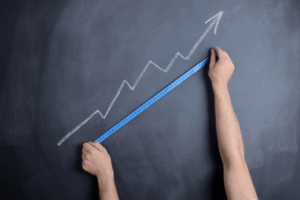
But fast-forward, six months later, he wrote a story. Within a week, I was on every news station within a year, including Bloomberg. Within a year, the book deal was finalized. I started doing more talks. Started being TED Talks about me. I was asked to do one, but then people started talking about my story. Between early 2013 and almost the beginning of the pandemic, I was really trying to slow it down.
It is hard to keep that level of pace with people, because they want to ask the same questions. It’s not that it’s hard, I’ll be honest. It’s hard to answer the same questions over and over again because you don’t want to be dismissive, as everybody’s hearing it for the first time. But you also realize, ‘this is really a law of diminishing returns? Every breath I take, that’s one less I have heard the people I love.’ My mind does really do math.
If I don’t have to use the steps right now, I now understand why my mom would make a stack at the bottom of the steps, because she only got so many flights right in her lifetime. It was remarkable. I think about it all the time. I still get asked constantly. Today’s my media day. I still get asked to do interviews and things from all sorts of people, including podcasts, writers, and especially book authors and academics. “Please show me how this works. Explain this to me.”
I feel fortunate, but it totally messed up my life because I was a regular person. I don’t want to say ‘I’m not a regular person,’ but I could have had a regular job as an IT person. But now, we live in a world where, since 2014, the first thing you do when you meet someone or you’re thinking about hiring someone is you look them up. Well, if you’d look me up, it’s over the top. I mean, what you thought. I’ve just kind of gotten used to saying “I’m a D-list internet celebrity who’s famous enough that I don’t have to do a regular job, but not so famous that I can just go to the mall.”
Wow, that’s cool. That’s a big deal online.
The person you want to be tomorrow already lives within you today. Share on XI still even get recognized at a mall. Like last summer, I was at a mall and some guy came in. I love everything you’ve ever done. Every time you post something. I don’t even do social media. Just because it was never about that. I never wanted to be an influencer for anyone other than myself.
It’s stupid. Mean, what do you do with that? I always say to people, they’re like, “Seriously, what would you do with it?” You know, most people are like, “You should do a podcast. You should do more like a TV show.” I did a TV show. I’ve appeared in a couple of TV shows. You should do one. But I don’t know. If you create content, you have to be consumed. I never wanted to be that.
There are some people who you think of not as they’re an influencer or a social media personality, but they’re just like a good human who’s really genuinely helpful. I think of Leo Laporte that way. It’s almost like meeting somebody you want to get to know as your neighbor, and then you meet them someday, and you’re like, ‘Wow, this is a nice guy.’ I really like him. He’s been around for a long time.
It’s so funny, I’m a big Leo fan, and I listened to Leo forever. Leo’s been around for at least 25 years. I’m not sure, but I recall him on Tech TV and in other collaborations with Chris Pirillo and the others. But I just wanted to say that I didn’t mean to interrupt you, but I’m going to tell you why I did. Just recently, I found his show again. It’s interesting to hear Leo now because hearing him talk about his son and how proud he is of his son as an adult and an influencer.
Out of all the names that I could pull out of my hat, it’s a good example of how we’re all connected. You’re the most connected. You can Google that and find that you’re on page one. I’m not sure if you’re still number one or maybe you’re number two, but that’s pretty impressive. A decade, what, a decade later? Yeah, but we’re also all connected. You and I and everyone listening, we’re all connected, and stuff that happens doesn’t just happen out of randomness, like that guy sitting behind you who just happened to be a reporter and was impressed by what you were doing with your calendars. That was a whole setup. That was just like a total synchronicity that was meant to happen for you. How do you measure that?

I actually measured synchronicity for a long time, too, because I put my life into three buckets. What I would call it is kind of like the quantified soft bucket, the one you mentioned, the one that’s kind of like your steps and all the normal stuff.
I then placed myself in the second kind of measurement bucket, which involved more time, specifically examining my time perception and how I work with time. That was really more time for my mental ability when I was learning to meditate.
I attended a couple of silent retreats lasting 10 to 15 days. It’s a long time to meditate. It really taught me to work with the nature of the mind. In Buddhism, it’s called dukkha. It’s the suffering. Dukkha is a Sanskrit word that means suffering, referring to how your mind interacts with other things and what makes you unhappy and happy. However, the third bucket was similar to the current one I’m just coming out of, which spans from 2018 to now, encompassing the more esoteric aspects of data.
Which would fall somewhere where time, time perception, and esoteric concepts could meet is basically known, albeit by happenstance in regular pedestrian thinking, as coincidence. But for other people, it borders on serendipity. ‘Where do those two meet? How would you measure them? How would you recognize them? Can you engineer it?’ Because a lot of what happens in your life feels like a coincidence on the lower side, deja vu at the lowest. Deja vu is just early onset coincidence, and coincidence is just early onset synchronicity. It was Freud who really did a lot of work with synchronicity.
It was young Carl Jung. He coined the term, actually, after a beetle was knocking on his third-story window in the middle of a session.
At first, I kept a journal. Every time it was a paper journal, it was like 2016 when I started doing this, whenever anything was some major, and for me, synchronicity had to be more than just me noticing something or feeling I’d done it before. It had to be two people in an intersection of something. When with two people, then you could say, “Well, what are the chances? With three or more people, you even get more of a nod.” I started doing that, and then I began looking for patterns, times, and dates. It was really what got me into it.
From working within the neurodiverse community, I’ve learned how easy it is for language to diminish real struggles and leave people feeling less than.
Believe it or not, pay attention to seasons and the moon cycle. What precursor to chronology, the Greeks call Kairos, this idea of seasons and seasonality. We have these kinds of times in life. My mother called menopause a change of life. She was born in the forties. No one uses the term change of life anymore. But I have sensed it’s grown and become an adult. I understand, like, no, for her, that was a new part of her life. It was a new season. That was a new type of womanhood.
Knowing that, and then kind of that system I showed you earlier, and just tying back, your pedestrian routine, day-to-day stuff to a particular point in time. It’s the smallest point in time you have the minute we’re in, but at the largest point of measured time that is even considered it and some normalize space without getting too far down the rabbit hole, you’ve got the celestial procession, which is the earth moving on its axis, which is every 25,000 years and change, and that gets us kind of the ages, the age of Aquarius, all these things people know of.
It’s when the Earth is tilted, which then replicates, further down to our 12 months of the year, which I’m not sure about. For me, even the Chinese New Year has a cycle like that. The Mayans had a similar cycle. It’s been really helpful to understand synchronicity through that lens. If I’m going to plan something, I will plan it around ‘woo.’
I pay attention to when Mercury is in retrograde and so forth. It’s a ‘why-why try and go against the flow? Why try to swim upstream?’ If this is a time when you’re supposed to be reflecting and rejuvenating and reevaluating and all that, and you’re instead signing contracts, doing big deals, buying expensive things when you’re just basically swimming upstream, you’re asking for trouble.
Every time. A lot of people get caught up in it, but it’s interesting because I’ve noticed the adoption of esoterica over the last 10 years. The curve is just out of control. How many people have just mainstreamed a lot of that type of thinking, and ‘woo’ was. It reminds me of the late seventies. There was a lot of this. I think we even referred to it back then as new age. A word for autistic children was called star children. We had all of the same things, but I think any student of history will understand that those patterns are more of a product of human life, just magnified by population.
A term also used to describe children of that era, and it is still used to this day for Indigo children.
A lot of people don’t even, it’s funny. Growing up, I was always told I was diagnosed with asperger’s, but apparently, that’s not a thing. I don’t know. Just remember, in school, before we even had a word for accommodations, my mom would tell people I needed that. But again, I just have a different way of thinking, one that makes sense to me.
You see that as a gift, right? That’s not like a disability or something like that. It’s like a superpower, right?
I created an infographic that summarizes my entire life, allowing providers and professionals to quickly understand me as a whole person, not just a patient with a problem.
I’ll be honest with you, Stephan, I’m cautious with the term’ superpower’ only because it’s natural for me to feel like I possess one. But I’ve learned that I’m going to use a lot of language that’s outside of my age set. I’ve learned from working with experiences within the neurodiverse community that it can feel less than, as it diminishes some of the struggles they have. I will agree with you because we’re from a time point in time where we could say that relatively comfortably for people who are listening, who might be more sensitive to something that makes life difficult for them.
Because, again, we all have different neuro types, each with unique ways our brain processes and handles information, and thinking. Neurodiversity is simply a collection of neurotypes. When you have ADHD, PTSD, and a bunch of other things that fall on the spectrum, my experience with my brain might be similar to someone else who was in different sets of conditions where they didn’t have the tools, frameworks or people around them to make them make sense.
I got a job in 1980 and lied about my age, claiming I was older than I actually was, so that I could buy a computer. But technology has always been a form of accessibility for me. Computers and working with them in the way I use them are how I express myself. It’d be hard for me if I were raised differently and couldn’t find and get those things to feel as super-power-ish as I do. But between you and me, it definitely feels like a superpower.
I’ve got probably undiagnosed ADHD, and I consider that a blessing. I don’t feel like I’m disabled or have a disorder or anything. I think that it helps me get into a hyper-focused state when I am in a flow state, triggered by the flow, or whatever. This helps me drop into that space, and then I can accomplish an incredible amount of work. I can be in a great deal of not just productivity, but also a creative genius.
Creativity is one of my feeling states that gets logged, because it’s a very special place for that. Remember, I told you when we first started talking that we discussed mapping emotions. Actually, I dug out the image that I created for myself. This was essentially my emotional journey stack. When I find flow, and when burnout happens, I come back. Until I can explain an experience or do something with a level that would help shield people from some of the pitfalls, I’m not resilient. It helped me focus on how my brain works. Even that chart, something as simple as that. Being in a state where I can articulate it and visualize it so I can share it with someone.
Introspection is powerful, but it isn’t for the faint of heart—it can be debilitating.
I have a chart also. I’ll find it during this call if it’s important to you and you’d like to see it. But when I meet a new healthcare provider, a dentist, a doctor, or anyone, even my doctors, lawyers, and our accountants, and all of that. It’s just a single infographic, a tall one. It’s my entire life with my current age at the top. Every decade, columns of traumas, accidents, deaths, and so on.
On the one hand, there is the emotional side, and on the other, the physical side, including surgeries and hospitalizations, and so on. However, this infographic allows me to summarize my entire life in a way that providers and professionals can quickly understand. I’m not just a person there with a problem in that moment. I’m a complete human being. Consider that when you are working with me.
Wow. That’s phenomenal. I don’t know of anyone else who’s done that. Having an ‘About’ page with a timeline of milestones helps build rapport and relatedness, as well as the like and trust factor, all of which benefit the visitor on your website. But this is a whole other level.
It’s not something I mean to share, but I have shared it publicly. I might even have an old one here I can bring up. I just found an old one. But it’s totally fine. But I’ve shared it online every now and then, especially with people who have health conditions, I need that for my doctor or ‘because my doctor doesn’t believe,’ or ‘doesn’t know a lot of reasons for it.’ Let me find the screen to share with you. It’s not showing.
I’d love to see it. If you’re willing to share it with my audience, that’d be great. It’d be really cool to map out your synchronicities in that similar sort of way because then you could say, “Look, I’m not crazy. This stuff is real. It’s documented. I have had multiple people witness this sort of thing. I had a whole party and a whole bunch of people all saw the UFO, not just me.”
You’ve had the behavioral issues over here and the medical issues over here from the day I was born, all the way through to this point in 2021. But it really helped me think in so many ways when I give it to a provider, professional, or someone I start to get to know better. A lot of people you share your stories with, but unless they see them together, that you were seven years from physical abuse to homelessness at 15, you were two years from homelessness the second time.
You were three years from that, your lover dying of AIDS in bed next to you in the early 90s. There’s a lot that you can talk about, but hearing is one thing, seeing it together and then seeing the associated behaviors, whether it’s drinking or drugging or surgeries or the medical effects of those things, it doesn’t quite land until you have a picture. I’ve been really fortunate with providers; they seem to like me, but they don’t. I’ll just phrase it like ‘it’s in my head. They don’t mess with me.’ If I say something’s going on, they go, “Okay, yeah, it is.”
Becoming deeply introspective while navigating multiple existential crises has been provocative but ultimately transformative.
Well, it’s a different level of respect, and you’ve done your homework and you’re introspective in a way that most people aren’t.
We don’t talk enough about introspection; it was a Socratic method designed to encourage self-reflection. Introspection is one of those things; it’s not for the faint of heart, and it can be debilitating.
That’s an interesting topic, too, because the default mode network is often the mode we operate in, without even realizing it. However, we can’t even stand in line for a minute without whipping out our phone and scrolling mindlessly on whatever social platform is our choice. That means you don’t have time to get bored. You don’t have time to look introspectively, to think about your purpose, or to navigate the existential crises that you might be going through.
I cultivated that behavior over the last 20 years by using countdowns, reminders, and systems that bring my life back to me. This is something Facebook does with the ‘This Day’ feature. But combining it with others, so the system I should drive something called milestones. However, another aspect that many people overlook is the pitfalls of being someone who’s very introspective and perhaps hyper-empathetic.
Where you really struggle with just feeling other people’s feelings. People are always like, “Why do you care?” I’m like, “That’s like asking me not to breathe. I don’t know. I don’t want to care. I want to be you.” I tell people that I want to have that feeling that it doesn’t matter. But I don’t have it. Asking me to change my eye color. But the thing I find most provocative with becoming a very introspective person and all living through several existential crises is how often I have to use my attention when I’m with other people in person, almost to pretend to be distracted, so they feel comfortable. Because giving someone your full attention seems to overwhelm them. I’m not sure if that’s getting worse just because people are so scattered. But I know that it works great on stage in front of a couple of hundred people or a couple thousand people when I’m asked to speak.
That gift is great because you can reach a lot of people very fast, almost like Cyclops from the X-Men, just burn through them. But in one-on-one conversations or in small groups with teens, people just like those from Gen Z stare. You shouldn’t do that. You don’t want to disarm people. I always tell people, “You have the ability.” Most people have done it in a moment of intimacy where they lock eyes with someone. That energy that happens when you lock eyes can be cultivated when talking about pizza; it’s just the different drivers at the moment. Sorry, that’s probably awkward.
That was great. Some of the things we do to set ourselves up for a sympathetic nervous state, rather than a parasympathetic one. I know one of the points in your book, and you’ve discussed this on video, is that setting your phone or having it on by default to show the percentage of battery left versus having it play just a visual of the amount of battery with a graphic. That’s very profound. It’s a metaphor for how we do life. You want to share that tip?
I started in 2009 doing something called Phone Palmistry. Oftentimes I’m gonna speak and organize where I have me do phone palmistry, but the long and short of it is basically people give me their phone unlocked, I don’t open any apps, and I just look at their home screenn and I kind of tell them about their lives because a lot of people adorn their home screen in a way almost like a value set. Right down from the lock screen photo on the home screen. But in doing that, I learned very quickly that people’s relationships to their phone battery percentages say a lot about how they embrace or do not embrace the world around them.
People who have that percentage on are usually more fine-tuned to a lot more control than those who can have it turned off. There was a period with iOS where they removed the ability to display the percentage. A lot of people were really not doing well. Likewise, I’m unsure what’s left for today. Because they were like, as any cyborg, right there’s nothing wrong with this. They have a really good ship with their device, and it serves as a feedback mechanism.
It’s like “Okay, how long do I have to plug in you know range anxiety in an electric car?” Well, it’s the same type of thing so I don’t think there’s any type of particularly interesting pathology, but I do think when working with yourself if you want to like just do some mental exercises if you’re someone who normally doesn’t have it turned on turn it on and if you’re someone who normally has it turned on, turn it off. When you notice yourself noticing that you need it, that’s a moment. That’s called cyber mindfulness; it’s a moment of awareness. Another great hack you can do with your phone is really simple for signboard mindfulness. It helps you slow down, create introspection, and convert the weather to Celsius. You’re gonna pause for a good second or for the first few weeks, maybe months, saying, “Okay, what is that again?”
Moods are just emotions strung together for a period of time, in which you can have a point of view. Share on XBut again, it’s about taking the habitual need to feed your information trigger and giving it a pause, which makes you reflect not only on what it is, but also why it isn’t convenient anymore. Another option is to set your phone to 24-hour time if you normally operate on a 12-hour clock. Seeing 1731, the first few months will really mess you up instead of 530. But it’s a great way again to take a beat and have a moment to be more mindful. Those are three quick ways to be more introspective with your devices while still being connected to them.
I love your tip that you shared. It’s in your book about organizing your apps, not by functional topic areas, but by color. That was really clever because I saw so many Zoom backgrounds where they have a bookshelf, and it’s all color-coded instead of just by type.
It’s everywhere now. Remember, it was 10 years ago. What I’ve noticed is that many people have started to do this. They’re starting to, when you embrace your inner cyborg, realize that you use machines, and machines are you. You are machines, and you are reflected through all the other things we don’t like to say out loud. You start to notice patterns. I noticed more people were color-coding, and it gave them a sense of Zen. When senses can get crossed, the term is synesthesia, where your senses become intertwined, allowing you to perceive things like tasting smells. That’s natural for the factory. But we’ll leave that on for a second.
But I noticed people were doing this with “Yes, exactly.” Neil Harbirsson’s cyborg, who can hear colors. With a sensor that he has built. That I was noticed was happening a lot. When I unpacked it a little, it made sense because your ability to visually perceive harmony was tied not to app usage, but to where the app fell within a terminating range. These big companies spend a significant amount of money focusing on the color of their app and the color of their icon. Again, it goes back to phone palmistry. Looking at a home screen, I often think you could make a billion dollars creating a dating app where you didn’t have a profile photo, it was just your home screen.
More people will be attracted to someone’s home screen than what they’re doing at the gym. At the end of the day, that’s how they spend their time. You can’t be with them at the gym. But that was a great thing that I learned very early on. Also, one of the other things I do, and I do to this day, is put my apps in folders by value. You have a health value or a family value. That’s a quick reminder, when you look at your phone and have to go into one of those folders, you see the value first.
It’s so funny. When I think about this book, it’s almost too far. It was almost too far ahead of its time. I would like to put it out now. But the other crazy thing is, it wasn’t called Don’t Unplug. It was called I Am You Tomorrow. It was really about understanding that the person you want to be tomorrow lives within you today.
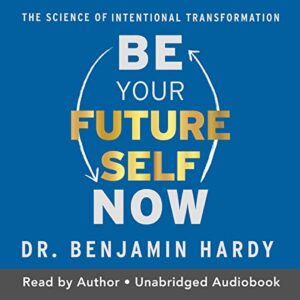
There’s a book by Benjamin Hardy called Be Your Future Self Now. Have you ever heard of that one?
No, I didn’t. But that’s exactly the point I was making. It’s like we have so much technology. It’s so easy. Another little hack I always share with people, especially those interested in Esoterica and technology, is to schedule an appointment in your calendar for one year from now. In that appointment, write down all the amazing things that have happened to you. You’ll forget this within a day. But within a year, if you actually said all those things, they will have come true. It’s a weird manifestation that is just surreal.
That’s cool. All right. I know we’re getting close to time here. We’ve got about 10 minutes left. I’d love to hear more about the wearables, implants, and other tools you have utilized and are currently using to help measure and make improvements in your life, as well as to foster introspection.
That kind of forces synchronicity back into your life. Back in 2008 to 2015, there were a lot of them, but the onslaught, the onset of the Apple Watch, gave us so many sensors in one. Cause you could get ambient sound, you could get ambient light. Your phone already has ambient light and could have ambient sound, but due to the way it locks it down, it wasn’t as convenient as your watch. At the same time, your watch now has sound settings. Today, I really focused on three core wearables. One of them is the watch, which now does more, including tracking blood pressure, which Google would have thought would happen.
I’m sure we’re just a couple of years away from blood sugar. I don’t need eyeglasses to see my computer, but I do have transition lenses or non-transition lenses. I call them bifocals; they’ve a top part where I can see distance and a bottom part where I can see up close. However, there’s a weird space where I need the glasses up close, but not here. Like I’ve got this middle zone. It’s like the personal space zone where I can see perfectly with my glasses.
But I love my glasses because again, they have cameras in them, like Google Glass. Google Glass is so weird. No, it was just early. They have AI built into them, and I can interact with them by talking to them and listening to the sound and music. My phone would now be number four, if you count the watch. My glasses are dependent. My phone now plays ambient background sound to help you focus, and it does so through the glasses.
The pendant is from a company called Limitless. They don’t pay me. Don’t know anything about them. They might be a fly-by-night. But I founded it last year, and it listens to you all day and keeps track of everything you said and all the things you promised that you would do. At the end of the day, it provides a summary of the tasks you said you’d complete. “Have you done them?” And it does a little bit of coaching. “Hey, I noticed you were talking, but you didn’t let the other person speak a whole lot.” There are some really provocative things, but that’s essentially my tech stack today.
I still have a house full of things. I can see the Hue light behind you. I still orchestrate a lot of that stuff within my home. Had guests over last night. The lights started dimming around [7:30] PM, and they’re like, “What’s going on?” I’m like, “I’m in bed by eight.” And they’re like, “We’re sorry, we didn’t know.” I said, “No, it’s not. Don’t worry about it. I like to expire at eight.” Well, it’s funny because I even do it in the winter. We actually drop.
The most important thing we can do today is to be present and supportive of one another. Share on XTemperature, if we have more than a few people here, automatically becomes louder, which encourages them to leave. In the summer, it’s the same type of thing, which can make people feel ambivalently uncomfortable, so they want to leave without being asked. Cybernetic. I don’t know. Things like that don’t require a lot of technology nowadays to stay on top of yourself. It takes a little bit.
That’s funny. But let’s take posture. You gave that as an example earlier, where you had a posture strap. I don’t know if you still have one. That’s not something that the Apple Watch covers; they’re gone. They’re out of business.
No, so that was covered by Lumo. I’m not even sure if they’re still in business. They’re gone. Yes, Lumo was great because, if you’ve ever considered how you’re sitting, most people aren’t even aware of it. It’s just one of those things; once you learn, it’s just one of those things. For posture, I am actually sitting on a lot of technology right now. Underneath my butt is something from cushion labs. I have something on the floor for my feet.
I have something, if you look up Cushion Labs, have something under my butt that kind of shapes to my back, and I have something right behind my shoulder blades like wings that kind of forces a good, and I’m even on like a Herman Miller chair. I’m also sitting in a really good chair, but I’m really focused on that. Again, how I sit is a result of my long-time acupuncture practice, which helps align my posture and, in turn, influences my behavior, thinking, and feelings. But I don’t wear a posture strap anymore.
Your phone does keep track of gait so that it can detect various types of slouching, tripping, and similar behaviors. There is a gait sensor on your phone now. Mean, who would have thought? If you’re getting to the point where you were having some ambulatory issues. In bed, again, I got an adjustable bed probably in 2017. Then put a sleep aid on it. I’ve had two sleep aids. That’s the one that drops the temperature of the mattress using water or increases it, heats it up. I still have a lot of things like that.
You’re ahead of the crowd for sure.
It’s weird because I think Stephan and a lot of the stuff are normal. As many people are aware, these things are well-known. I mean, I don’t know. A lot of people have a sweet pain. I met a lot of young people who are knowledgeable about things like the Eight Sleep mattress and Hue lights. I mean, they know these things. They know that Hue has a setting to help with the circadian rhythm.
Well, they may know about it, but you’re actually using it, which is a big jump—the people who know, like, “Yeah, I’ve heard a Lumo.” I actually had a Lumo lift that I think I wore once. Perhaps I never even wore it. It’s like I have all the gadgets, but I didn’t actually apply to even half of them. I have a Muse S Headband that I’ve never used. I’ve literally never used it. I’ve used them. The Muse 2 got that in a box somewhere. I haven’t used it in years, but I got the Muse S. I love the shiny objects. I buy it and then I don’t use it.
My experience with Muse, having met the CEO a few times at various events, was a little different. I was meditating at that point. I was an active meditator. I had been going to Shambhala and had attended retreats. When I got my first Muse, I got my first one in 14 or 15. It was really interesting because I was like, “How well am I doing?” Which kind of taught me like, “My God, if I’m asking the question, I’m not doing well at all.”
A lot of meditation is about non-judgmentally being aware of the present moment. Like, “My gosh, I’m fucking sorry. But I’m doing everything wrong that I’ve been taught not to do.” It’s like the tool kind of messed me up that way. But then I started actually using it when I’m meditating, and I can drop myself into a state really quickly. I can just go there like with my mind. But what I liked about it was that I learned to do that not from sitting, but using the Lumo.
There was an app that just gave you the raw feed from the Lumo, not the Lumo bull crap, the birds and all the other stuff. Seeing the raw feed helped me actually go from, and in my Dark Net TV episode, I do it on there. So they asked, they’re filming me meditating, and then I’ve got the Lumo in front of me, and they’re like, well, you know, drop your mind down into one of those states. It looks remarkable. But I couldn’t have done that if I didn’t know, I had to say it, but what they felt in their whole body. I know what they felt like when I’m in a meditative state, but to actually say “I’m going there right now without that visual feedback,” but like you said, after I did that, I was like, “I don’t really need the luno anymore.” I’m sorry, the muse. Yes, sir. I was talking about the muse my entire time.
Oh, you mean the muse?. The birds don’t, there’s no chime. There are no birds chirping in the LUMO output.
I actually use birds now, though, in my home. Depending on the season, have a song for that particular season. I just pulled the Ravens out of the system the other week.
That’s cool. One of the things I do to get into a kind of productivity zone, to get into a flow state, is I’ll play the sound of rain with occasional thunder and so forth. I’ll start working on something I don’t want to do, like eating the frog, as Brian Tracy would say. I work on that. Turn on the sound of a storm with rain and everything, and it helps, it really does. If it’s birds, if it’s rain, if it’s a busy cafe, I’m on the iPhone, but this is an app on my laptop. It’s noisy.
Are you an iPhone or Android user? Interesting, the iPhone now has an accessibility feature that plays background sounds, just like you’re describing; they’ll play randomly in the background for you. They’re cool. I bet 26 will end up. You have a Mac too, so I wouldn’t notice a lot of things that, like the noisy O, become popular; some Apple just steals the idea. It’s fun. I love sounds. I really love smells back here. See these two little bottles? If you zoom in, I can pinch and zoom, but there are two little bottles right here.
There was a place in the 80s, if you were a mall person, called Crabtree & Evelyn. I think it might still be around, but I’m not sure. But they had a scent called Moroccan Mist, which is ironic, as it’s a bit of a rumor. Don’t make it anymore; I haven’t made it in years. But as a kid, I would buy it because I loved it. It smelled kind of oriental or exotic, or it was just one of those smells that you wouldn’t get all these different things together.
But now, whenever I want a hit of the past, I will spray it in the air. It’s amazing to instantly go back to your teenage bedroom and relive those feelings just by closing the door. I don’t know if you’ve noticed, but there are a lot of influencers now who are their entire shtick, and there are a lot of AI videos where they just take you back in time like a 70s living room, and it’s just an AI video of like regular people just sitting in a 70s living room. We’re so close to some form of cognitive time travel in the future. Sorry, I’m just going on a rant now, but just seeing what they’ve done with The Wizard of Oz in Vegas blows my mind. It’s so exciting.
I haven’t seen that.
They’ve made it; they put it in the sphere. They used AI to take their original The Wizard of Oz film and then expand it way beyond, and show you things you would have never seen by extrapolating the scenes and drawing what should be there. It’s mind-blowing. You really find it interesting, Stephan.
I appreciate your authenticity, vulnerability, and openness in sharing things like all this data, your journaling, and infographics about your life. I want to give you kudos for that. You’re helping people, too, by modeling this and being more authentic and vulnerable in the world. The world needs that. I know we have to wrap this up, but what would be a quote that really resonates with you? Something you want to leave our listeners or viewers with.
Okay, the first one I end every keynote with, so it’s always been super important to me once I learned it and realized how much it messed up my life. That is, we don’t know how to measure what we care about, so we care about what we measure. The world hands every person on earth a set of metrics, and whether they’re family metrics, life metrics, or job metrics, we often ruin ourselves over those things. Just know what you care about and then measure it relentlessly.
The second one is kind of dumb, but it’s something that got me in a lot of trouble, and I think about it, especially as I get older, and it has a swear word in it, but you can’t save your ass and your face at the same time. That one, between those two sayings, the more mindful you are of the measure, you care about your daily measure, and you can’t save your ass and your face at the same time, they just help every single day, because every single day I find those two situations in my life.
That’s great. All right. If our listener or viewer wants to learn more from you, they may want to obtain your book, follow your social media, or, if you’re not on social media, consider joining.
It’s not really on social. I have a Facebook fan page, but I don’t really utilize it. The book is now out of hard print and available in paperback. I don’t know if they’ll do it or not. It’s available on Kindle, and it’s also on Audible, where it’ll remain for the foreseeable future. I have a website called chrisdancy.com. The only thing that’s really out of there is a lot of information we discussed today, but there’s also a contact page.
I tell people all the time, my phone number is literally on that page. If you’re listening to this now and think, ‘Oh my gosh, this really blew my mind,’ or ‘Oh my gosh, I am struggling,’ my spouse would tell you I get phone calls a few times a week from absolute strangers. I’m always around. I believe that the most important thing we can do is be there for one another. If you ever need anything, that’s how you can find me. You literally pick up the phone. I’m from the 80s. When I pick up the phone, I answer. So it’s cool.
That’s great. You’ve saved people’s lives with your book. I don’t know. That’s what my intuition tells me.
That’s very kind. I’ve definitely been told it’s changed people’s perspectives and helped them a lot, but I’ve never heard that. That’s beyond a level of awareness that I’m capable of having right now in this moment.
All right, well, thank you so much, Chris. And thank you, listener, thank you, viewer. Go out there and make the world a better place. We’ll catch you in the next episode. I’m your host, Stephan Spencer, signing off.
Important Links
Connect with Chris Dancy
Apps and Tools
Books
Businesses/Organizations
Films
People
YouTube Videos

